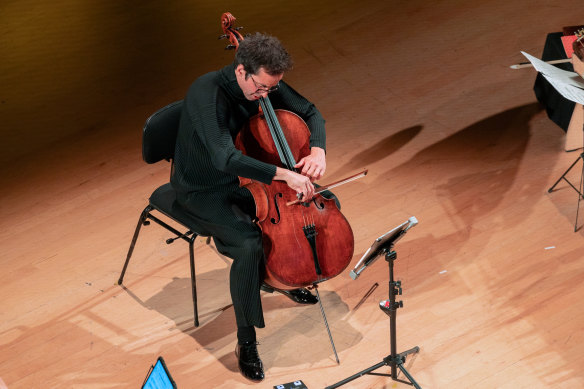Musica Viva’s new commission evokes charmingly irritating earworm
By Peter McCallum
MUSIC
Silk, Metal, Wood ★★★½
City Recital Hall, August 14
French cellist Jean-Guihen Queyras began the concert from Musica Viva with the noble solitude of Bach’s Cello Suite No. 1 in G Major, and ended it with a companionable Duo for Two Cellos by Offenbach, performed with Switzerland-based young Australian James Morley.

French cellist Jean-Guihen Queyras performs at City Recital Hall.Credit: Annelise Maurer
In between, the concert reached the musical apogee of these two points with a new work for two cellos and Japanese koto, Eclogue, by young Australian Jakub Jankowski, which, at its gravity-defying climax, left the musical orbits of both Bach and Offenbach. Koto solos played by Satsuki Odamura and an atavistic return to Bach’s spirit in the form of Britten’s Cello Suite No. 1 spanned the distance back to earth.
If the audience was a little startled at interval after Jankowski’s piece, they left at the end with one of those charmingly irritating earworms that Offenbach does so well. Those who were there are probably still trying to get it out of their heads.
Queyras performed Bach’s suite like one playing alone, drawing the tone back to intimate quietness, letting the fast movements run quickly, and leaving the voice-leading connections (Bach writes with one “voice” but implies many) to take care of themselves.
In Midare by 17th-century koto player and composer Yatsuhashi Kengyo, Odamura explored wispy sounds and slow harmonics.
Jankowski’s Eclogue began with sounds on the cellos evoking abject stillness to which the koto added sharply pointed, vivid micro-inflections portending something strange. Quiet sustained notes built tension until they broke with a searing flash. Fluted tones up and down the fingerboard evoked the voice of spirits, while Queyras soared to an intense point of liftoff, before the end faded in quiet birdsong.
After interval, Odamura introduced a new aspect of the koto’s character in Robin Williamson’s Letter from a Stranger’s Childhood. Plucked with bare fingers rather than the usual plectra, it sounded more like a folk harp, mixing warmth with occasional sharp punctuation.
In Britten’s Cello Suite No. 1, Opus 72, Queyras again created a personal, quiet space, sometimes bringing the tone down to a barely audible sigh. The second movement, Fuga, skipped playfully, while the sixth movement, Marcia, conjured an image of a distant parade with a hint of the fantastic.
Queyras and Morley played Offenbach’s duo with coy grace and tapered phrases, gliding around virtuosic passages with brilliance and whimsy.
Silk, Metal, Wood is also at City Recital Hall on Saturday, August 19.
Find out the next TV, streaming series and movies to add to your must-sees. Get The Watchlist delivered every Thursday.